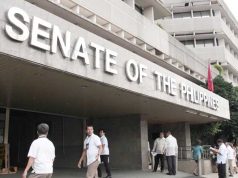Honoring those who died in the Battle of Manila
“Hundreds of refugees huddled in the ruins of Santa Rosa College in the Walled City. Included among them were the doctors, nurses, and patients from San Juan De Dios Hospital as well as families forced out of the Manila Cathedral. The ruins resembled a squatters community with makeshift tents constructed from corrugated metal tucked amid the scorched and crumbling brick walls of the school. The artillery shells whistled continually overhead even as refugees boiled rice over outdoor fires. Tension soared, as Japanese marines periodically showed up to drag off groups of men.” — Rampage, James M. Scott

APPROACHING the close of World War II, Japanese and American armed forces clashed in the Battle of Manila which lasted throughout the month of February in 1945. By the time it was all over on March 3, the once beautiful city of Manila was battered, its buildings lay in ruins, and over 100,000 civilians lay dead.
In 2009, artist and cultural worker Carlos Celdran spearheaded the Manila Transitio 1945, an event meant to commemorate the events and the people who died during the Battle of Manila.
“At that time, save for a pocket event or two, nobody was talking about the Battle of Manila and its horrible consequences on the City of Manila,” Manila Transitio event coordinator Benjamin Canapi wrote in an e-mail to BusinessWorld.
“It’s easy to understand that the survivors of the Battle of Manila would want to put the war behind them and pick up the pieces of their lives, but that also meant that, over the next few decades, the dreadful aftermath of the war was never truly acknowledged. It was like we willed ourselves a collective amnesia,” he wrote.
“We wanted so desperately to forget the war. Now, we don’t even remember.”
Despite circumstances that almost led to the postponement of this year’s Transitio, “the Intramuros Administration and some concerned individuals felt that the event is too important for it not to be staged,” Mr. Canapi wrote, noting that they hope to continue the legacy Carlos Celdran started.
WHAT’S IN STORE
The 10th Manila Transitio will be held at the Baluarte de San Diego on March 2 beginning at 5 p.m.
“Manila Transitio has always been a relaxed celebration of sorts. It’s a big picnic, basically,” Mr. Canapi said.
Activities will include a public picnic, art exhibition, open air performances, and a community ritual.
“The cleansing ritual is done every Transitio to remember everything we lost during the Battle of Manila,” he wrote. “We do a ritual to give peace to their souls and to find peace within ourselves.”
At the event, guests may bring their own blankets, picnic baskets, and even pets. Food and drinks will be available from vendors on-site.
Performing this year will be Alex Alcaraz Fernandez, Jean Paul Zialcita, the UP Repertory Company, Kooky Tuason, Marty Tengco, Charms Tianzon, and Joee & I. The Cleansing ritual will be done by Opaline Santos.
“We need events like Transitio to help us remember crucial events in our history, such as the Battle of Manila. History can easily be forgotten or worse, rewritten, if people do not keep the flame of memory alive. Events such as Manila Transitio help us give form and substance to our collective memory, making it easier to remember and appreciate,” Mr. Canapi wrote.
“We want people to walk away from Transitio with a deeper appreciation for all the City of Manila has lost. We want to remind the people of Manila how beautiful we once were. We want to reach out to the souls we have lost and tell them their sacrifice was not in vain,” he added.
The Manila Transitio 1945 entrance fee is P200. For information, visit www.facebook.com/puesto.manila/
One can also take a tour with Manila For A Day, Don’t Skip Manila, and Bambike Ecotours on March 2, and get into Manila Transitio for free. WanderManila, on the other hand, will be staging a special Performance Tour on March 3. — Michelle Anne P. Soliman



